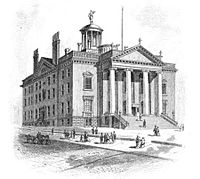46th New York State Legislature
| 46th New York State Legislature | |||||
|---|---|---|---|---|---|
|
|||||

The Old State Capitol (1879)
|
|||||
| Overview | |||||
| Jurisdiction | New York, United States | ||||
| Term | January 1 – December 31, 1823 | ||||
| Senate | |||||
| Members | 32 | ||||
| President | Lt. Gov. Erastus Root (Buckt.) | ||||
| Party control | Dem.-Rep. (unan.) | ||||
| Assembly | |||||
| Members | 128 | ||||
| Speaker | Peter R. Livingston (Buckt.) | ||||
| Party control | Bucktail | ||||
| Sessions | |||||
|
|||||
| 1st | January 7 – April 24, 1823 |
|---|
The 46th New York State Legislature, consisting of the New York State Senate and the New York State Assembly, met from January 7 to April 24, 1823, during the first year of Joseph C. Yates's governorship, in Albany.
A Constitutional Convention met from August 28 to November 10, 1821, and the new Constitution was adopted by the voters in January 1822. Under the provisions of the New York Constitution of 1821, 32 Senators were elected on general tickets in eight senatorial districts for four-year terms. They were divided into four classes, and every year eight Senate seats came up for election. Assemblymen were elected countywide on general tickets to a one-year term, the whole Assembly being renewed annually.
The new Constitution legislated Gov. DeWitt Clinton and Lt. Gov. John Tayler out of office at the end of 1822. Besides, the Council of Appointment was abolished, and the State officers were to be elected by the State Legislature.
On April 12, 1822, the Legislature re-apportioned the Assembly districts. All previously existing multiple-county districts (except Hamilton and Montgomery) were dismembered, and every county became a district. The total number of assemblymen was increased from 126 to 128.
On April 17, 1822, the Legislature enacted that future State elections be held on the first Monday in November and the two succeeding days.
At this time New York politics were dominated by the Bucktails faction of the Democratic-Republican Party. The opposing Democratic-Republican faction, the "Clintonians" disappeared after DeWitt Clinton decided not to run in the New York gubernatorial election, 1822; and the Federalist Party had virtually disbanded. Nevertheless, in some districts Clintonian or Federalist Senate and Assembly tickets were put up in opposition to the Bucktails (which were considered the "regular" Democratic-Republican nominees), but without much success.
...
Wikipedia
